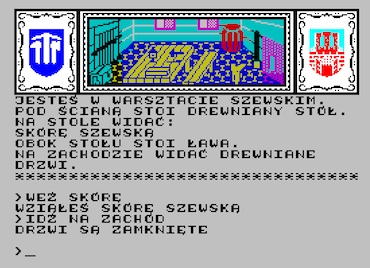Smok Wawelski (1987)
Early Polish text adventure games
 Smok Wawelski (eng. Wawel Dragon), published in 1987 for ZX Spectrum and Atari, created by Piotr Kucharski, Wiesław Florek and Krzysztof Piwowarczyk, represents a big step forward into more advanced, original interactive fiction in Polish language. The graphical formula of Hobbit and Mystery House, that was partially followed by the first Polish IF Puszka Pandory, was even more developed in this project. The text was accompanied by graphical window sporting several colors on its palette. Most importantly, the window was relatively detailed, giving a useful insight into a given location. It made it easier for players to remember what subjects could be picked up, move or use, without the need of going back to the dialog lines. After Smok Wawelski it must had been virtually impossible to write an IF game without the helpful graphics. There was no going back to text-only (and ASCI art) aesthetics of early games.
Smok Wawelski (eng. Wawel Dragon), published in 1987 for ZX Spectrum and Atari, created by Piotr Kucharski, Wiesław Florek and Krzysztof Piwowarczyk, represents a big step forward into more advanced, original interactive fiction in Polish language. The graphical formula of Hobbit and Mystery House, that was partially followed by the first Polish IF Puszka Pandory, was even more developed in this project. The text was accompanied by graphical window sporting several colors on its palette. Most importantly, the window was relatively detailed, giving a useful insight into a given location. It made it easier for players to remember what subjects could be picked up, move or use, without the need of going back to the dialog lines. After Smok Wawelski it must had been virtually impossible to write an IF game without the helpful graphics. There was no going back to text-only (and ASCI art) aesthetics of early games.
If Puszka Pandory was written as a result of its author testing of ZX Spectrum, Smok Wawelski, in terms of its plot development, seems to be testing its own innovative parser model. Storyline is sparse and episodic. Players wander around a town, its taverns and the surrounding landscape. Their main task is to face the Wawel Dragon.
Smok Wawelski's biggest achievement was its parser and dictionary. Both marked a considerable improvement over solutions found in Puszka Pandory. Game accepted full sentences in different syntactical configurations (far more flexible in Polish than English). Accepted were characters with Polish diacritics, like Ć, Ś, Ź or Ł.
Creators of Wawel Dragon soon formed a team with two more game designers, formed a company (Computer Adventure Studio) and 2 years later developed their new game: Mózgprocesor.
Mariusz Pisarski
- Techsty- archiwum
- Techsty issue 1
- Techsty issue 2
- Techsty issue 3
- Techsty issue 4
- Techsty issue 5
- o Techstach
- wizytówka
- about Techsty
- in English